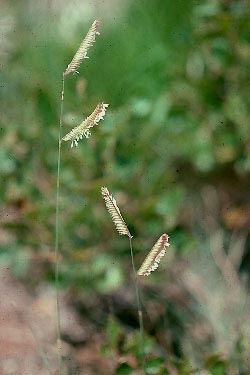Blue Grama

Common Name(s):
Blue Grama
Scientific Name:
Bouteloua gracilis (Willd. ex Kunth) Lag. ex Griffiths
Scientific Name Synonyms:
None known
Symbol:
BOGR2
Description:
Life Span: Perennial
Origin: Native
Season: Warm
Growth Characteristics: Low-growing grass with seed stalks 6 to 20 inches tall. It is a bunchgrass with short rhizomes, often forming an open sod by tillering. Starts growth in May or June, flowers in July to August, and reproduces primarily from tillers. Cannot tolerate shading by taller plants.
Seedhead: One-sided spike up to 2 inches long that is curved and comb-shaped at maturity. Spikelets are numerous, arranged in two rows on one side of the rachis, each containing one perfect floret and two imperfect florets reduced to bristles and scales; lemmas of perfect floret three-awned; glumes hairy and awn-tipped.
Leaves: The blades are narrow, mostly basal, sometime curled but generally flat, 1 to 6 inches long, usually glabrous but sometimes hairy on the margin near the base, folded to slightly rolled in the bud. Sheaths glabrous; collar with a few hairs at the margins; ligule a fringe of very short hairs; auricles absent.
Ecological Adaptions:
Blue grama is native to a wide variety of sites of Utah from elevation of 3500 feet up to 8000 feet. It occurs on open plains, mesas, foothills, and woodlands. Annual rainfall is 8 to 15 inches. It is found on sites where summer precipitation comprises a large percentage of the annual rainfall.
Soils: Blue grama will grow in soils with a wide variety of characteristics -- stony, cobbly, gravelly, sandy, or even fine soils with a high content of lime. It is not found in wet, poorly drained soils.
Associated Species: Needle-and-thread, sandberg bluegrass, galleta grass, and rabbitbrush.
Uses and Management:
Being a warm-season grass, Blue grama provides good quality summer grazing for all classes of domestic livestock and many wild animals. As it matures it remains fairly palatable and nutritious. Blue grama can withstand relatively heavy grazing and is very drought resistant. However, in Utah, because of precipitation patterns, it is a low producer.
Blue grama performs well as a bunchgrass where no more than 50 percent of the annual growth is removed during the growing season or 60 percent removal during the dormant season. It provides forage for year-long grazing, but rotational grazing is recommended to promote good herbage yield. It has good watershed stabilizing features particularly for reducing wind erosion and minimizing sheet erosion from water.

